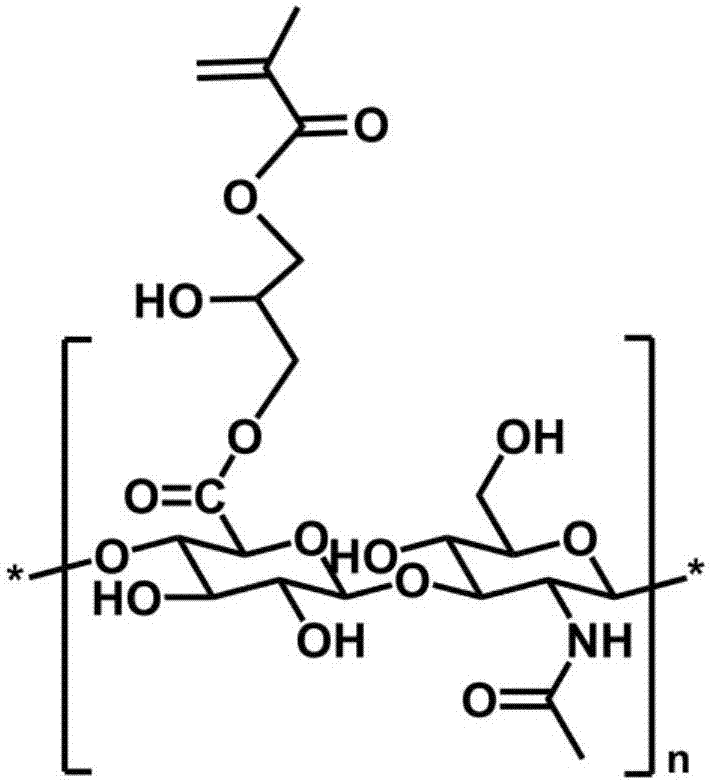Preparation method of sensor electrode surface anti-biological-pollution coating
An anti-biological pollution, sensor electrode technology, applied in the direction of electrochemical variables of materials, etc., can solve the problems of blood component metabolism detection error, blood sample centrifugation pollution, unable to fully express the real situation, etc., to achieve long-term stable anti-biological pollution ability, Strong anti-biological pollution ability and the effect of inhibiting non-specific adsorption
- Summary
- Abstract
- Description
- Claims
- Application Information
AI Technical Summary
Problems solved by technology
Method used
Image
Examples
Embodiment 1
[0028] A preparation method for an anti-biological contamination coating on the surface of a sensor electrode, comprising the following specific steps:
[0029] (1) Synthesis of photosensitive hyaluronic acid
[0030] Dissolve 1.0g of hyaluronic acid (HA) in water and stir until completely dissolved to form an aqueous solution of hyaluronic acid; add 4-dimethylaminopyridine (DMAP) (40% mol. relative to the number of HA repeating units), formazan Glycidyl acrylate (GMA) (10 times the number of HA repeating units), tetrabutylammonium bromide (TBAB) (80% mol. relative to the number of HA repeating units), react at room temperature for 48h; precipitate the reaction solution with acetone , transferred to a dialysis bag for dialysis against water for 4 days; the dialysis solution was freeze-dried to obtain photosensitive hyaluronic acid HA-GMA, which was stored away from light for later use;
[0031] (2) Preparation of anti-biological contamination coating
[0032] Dissolve 50mg o...
Embodiment 2
[0034] A preparation method for an anti-biological contamination coating on the surface of a sensor electrode, comprising the following specific steps:
[0035] (1) Synthesis of photosensitive hyaluronic acid
[0036] Dissolve 0.5g of hyaluronic acid (HA) in water and stir until completely dissolved to form an aqueous solution of hyaluronic acid; sequentially add 4-dimethylaminopyridine (DMAP) (100% mol. relative to the number of HA repeating units), formazan Glycidyl acrylate (GMA) (5 times the number of HA repeating units), tetrabutylammonium bromide (TBAB) (100% mol. relative to the number of HA repeating units), react at room temperature for 24h; precipitate the reaction solution with acetone , transferred to a dialysis bag for dialysis against water for 7 days; freeze-dried the dialyzed solution to obtain photosensitive hyaluronic acid HA-GMA, and stored it away from light for later use;
[0037] (2) Preparation of anti-biological contamination coating
[0038] Dissolve...
Embodiment 3
[0040] A preparation method for an anti-biological contamination coating on the surface of a sensor electrode, comprising the following specific steps:
[0041] (1) Synthesis of photosensitive hyaluronic acid
[0042]Dissolve 1g of hyaluronic acid (HA) in water and stir until completely dissolved to form an aqueous solution of hyaluronic acid; add 4-dimethylaminopyridine (DMAP) (200% mol. relative to the number of HA repeating units), methyl Hydroxyethyl acrylate (HEMA) (20 times the number of HA repeating units), tetrabutylammonium bromide (TBAB) (400% mol. relative to the number of HA repeating units), reacted at room temperature for 12h; the reaction solution was precipitated with acetone, Transfer to a dialysis bag for dialysis against water for 7 days; freeze-dry the dialyzed solution to obtain photosensitive hyaluronic acid HA-HEMA, and store it away from light for later use;
[0043] (2) Preparation of anti-biological contamination coating
[0044] Dissolve 100 mg of ...
PUM
 Login to View More
Login to View More Abstract
Description
Claims
Application Information
 Login to View More
Login to View More - R&D Engineer
- R&D Manager
- IP Professional
- Industry Leading Data Capabilities
- Powerful AI technology
- Patent DNA Extraction
Browse by: Latest US Patents, China's latest patents, Technical Efficacy Thesaurus, Application Domain, Technology Topic, Popular Technical Reports.
© 2024 PatSnap. All rights reserved.Legal|Privacy policy|Modern Slavery Act Transparency Statement|Sitemap|About US| Contact US: help@patsnap.com










